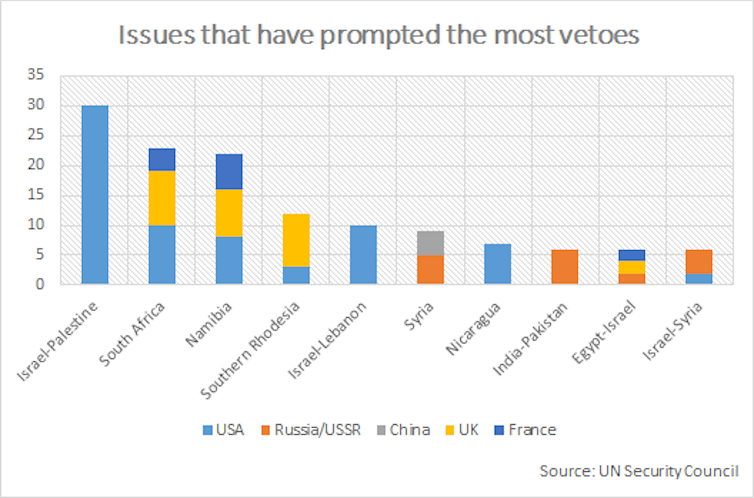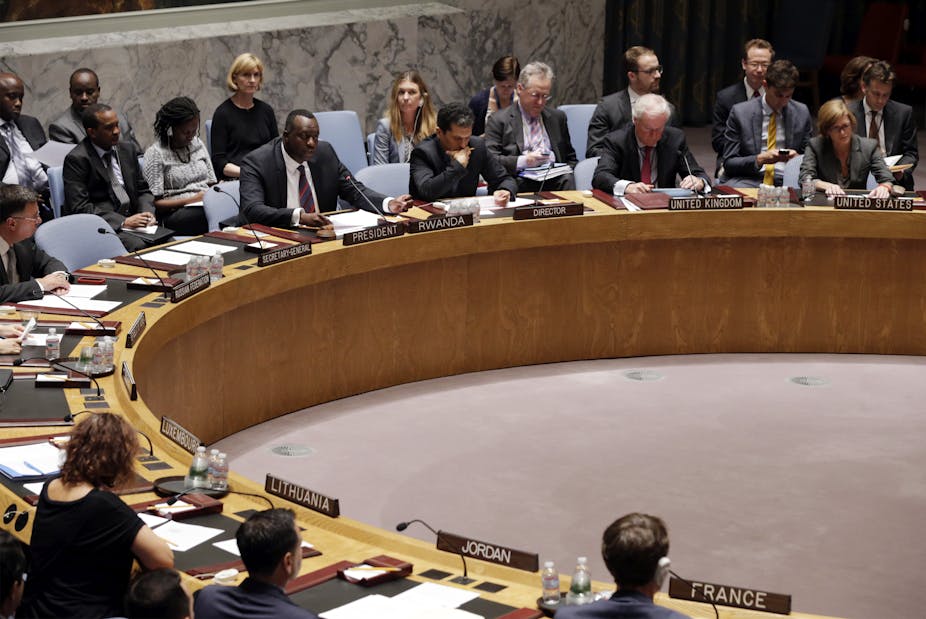On Thursday July 17, 298 people lost their lives when Flight MH17 was downed in eastern Ukraine. Almost immediately accusations were made that the aircraft had been shot down by pro-Russian separatists operating in the area. The same day, 25 Palestinians lost their lives (despite a five-hour humanitarian ceasefire being apparently in force) as Israel launched phase two of Operation Protective Edge, among whom were four boys killed as they played football on a beach.
Two international crises for the UN Security Council to handle. But the responses could not have been more different. Responding to the downing of MH17, on July 22 the Security Council passed a resolution drafted by Australia that called for for an independent investigation and full access to the site and asked Russia to ensure separatist groups allowed this. Russia was also enjoined to use its influence to bring the conflict in eastern Ukraine to a close. While the resolution may be criticised for not going far enough, it may be seen as a success for the pursuit of international justice in the face of previous Russian intransigence on the eastern Ukraine situation.
Russia had previously vetoed a resolution on the situation in eastern Ukraine and, a mere two months later, chose not to exercise its veto.
Debate on the escalation of Operation Protective Edge in Gaza was heated, with more than 60 states participating and on the day after the Security Council passed its resolution on MH17, the president of the Security Council, Eugène-Richard Gasana of Rwanda, made a statement deploring the number of civilian deaths and calling for a cessation of hostilities but recognising Israel’s right to self-defence.
This fairly rote statement, made with the death toll standing at more than 600 civilians (it is now estimated at more than double that) is in stark contrast to the rapid and unanimous resolution on MH17 and – as ever, the pressure is on the Security Council to act to protect civilians. But, as ever, the possibility of a US veto looms over the Council, casting doubts on whether humanitarianism will prevail over national interests.
And here is the irony. When a resolution was mooted over the downing of MH17, many observers expected Russia to exercise its veto right as a member of the P5 – the five permanent members of the Security Council which also includes the US, China, Britain and France. But Russia voted with the rest of the Security Council (and, let’s not forget, it may well have been in Moscow’s interests to do so, given that it may be that a full investigation finds that Russia is not in any way implicated in the incident as is so widely believed).
These contrasting responses are not an anomaly. The history of the Security Council is replete with similar examples: when an expected veto does not materialise or when a veto blocks action when such action seems all-too necessary. The influence of the veto on the outcome of the Security Council deliberations is well known. But perhaps what is less well known is that Russia is no longer the main offender when it comes to wielding its veto. And that the old “truism” that the veto is exercised solely in pursuit of national interests, may no longer hold.
Who vetoes what
The UN Charter does not explicitly mention the P5’s veto power. Instead it stipulates that, for a resolution to pass, it must receive nine affirmative votes of the 15 member states on the Council, including the concurring votes of the P5. Hence, a negative vote cast by one or more of the P5 is, in essence, a veto.

During the Cold War the veto was exercised extensively. The USSR clocked up an impressive 68 vetoes with the US in second place with 61 vetoes - there were other vetoes, often from the USSR or the US, which were simply tit-for-tat blocking of other countries’ applications to be members of the UN – for example Russia blocked Japan, considering it to be too subject to influence from the US, while US blocked Vietnam’s application after 1975. The UN tends to omit these vetoes when calculating its data.
Both states blocked resolutions on their Cold War activities. Thus the USSR vetoed resolutions on its “assistance” to Hungary following the 1956 revolt, its 1968 invasion of Czechoslovakia and its 1989 invasion of Afghanistan. The US similarly blocked a resolution on its 1983 invasion of Grenada while its involvement in the Vietnam War was not even considered by the Security Council. The US also blocked resolutions on its activities in support of the Contra rebels in Nicaragua – activities which the International Court of Justice found illegal in 1986.

Britain has used its veto most often over southern Africa – including South Africa and Southern Rhodesia (now Zimbabwe), acting, in the main, in concert with the US and, less often, France. This intransigence was set against an increasingly vociferous General Assembly on the issue of racism generally and the situations in Southern Rhodesia and South Africa specifically. The UK also consistently blocked, at times with help from the US and France, resolutions on the independence of Namibia. This was notwithstanding repeated General Assembly resolutions and an advisory opinion of the International Court of Justice.

The use of the veto during the Cold War is a story of the pursuit of national interests - even in the face of contrary world opinion and reasoned judicial decisions. That said, the Security Council did manage to pass more than 600 resolutions between 1945 - 1989. While many of these pertained to more procedural matters, such as the admission of states and the appointment of the Secretary-General, neither matter was immune from the vagaries of cold war rivalries and the national interest.

Towards the end of the Cold War, there was a decline in the use of the veto which has continued into the post-Cold War era. Some 29 resolutions have been vetoed with 35 no votes cast by the US, Russia and China. The UK and France last exercised their veto in 1989 (on Panama). The US is now the most frequent user of the veto having resorted to the veto 16 times between Jan 1990 and the present – the overwhelming majority of which (14) pertain to the Israel/Palestine situation.
The Russian Federaion (as distinct from the USSR) comes in second with 11 vetoes – six of which have been issued jointly with China. China has also used its veto (along with Russia) to block a Security Council resolution condemning political repression in Myanmar. Both states were concerned that the Security Council was overstepping its international peace and security mandate by unduly interfering in the internal affairs of Myanmar. They offered similar reasons for blocking a comparable resolution on the situation in Zimbabwe in 2008. China, in particular, has resisted the turn to humanitarianism to justify a role for the Security Council in what it sees as the internal affairs of states.
However, the concern as to respecting principles of the charter – specifically the principle of non-interference – came to a head in 2012 with the Libyan situation. The UN had previously endorsed the idea of the responsibility to protect populations from atrocity crimes and references to it peppered the Security Council debates and resolutions on Libya. Notably, Russia and China refrained from exercising the veto, arguably putting humanitarianism above respect for the principle of non-interference and, perhaps national interests.
However, both saw the consequent intervention as going too far and, as shown by the four vetoed resolutions on Syria, returned to citing Security Council over-reach and the principle of non-interference.
What now for the Security Council?
There’s no doubt that the number of vetoes used at the Security Council has fallen since the end of the Cold War and the break-up of the USSR – while the number of resolutions, in particular unanimous resolutions, has grown exponentially over the same period, suggesting a co-operative and working Security Council. Yet the veto remains and arguments continue as to how and when it is used. The debate has evolved beyond national interests to include observing the letter, or the spirit, of the UN Charter, and protecting the most vulnerable at times of humanitarian crisis.
Following the deadlock over Syria – and drawing on the Responsibility to Protect – France proposed a “code of conduct” for the P5. Here, the permanent members would pledge not to use the veto in cases of humanitarian crises, especially where atrocity crimes are at issue. It is the latest in a long line of such proposals and the worsening humanitarian situation in Gaza shows a Security Council torn between national interests and humanitarianism. Perhaps it is time to decide who or what the Security Council is for.

